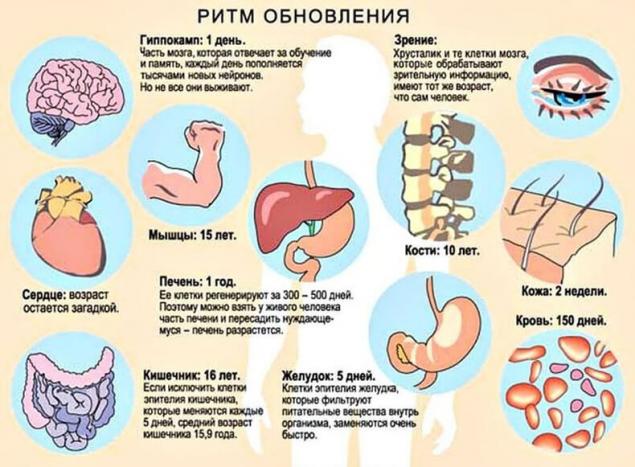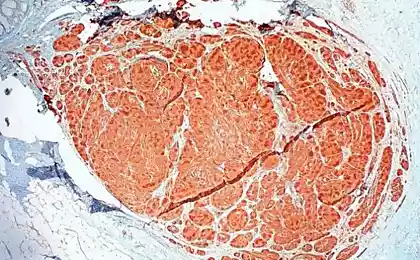533
How old are you actually
Take your time to answer this simple, as it seems, the question, because you answered the Swedish neurologist Jonas Friesen: each adult on average fifteen and a half years. If the passport you, for example, sixty, the lenses of your eyes on average of 22 weeks over the brain about your age, but your skin just two weeks old.
Different organs and tissues of the person are updated at different speeds, and therefore we can say that they have different age.
One popular science workbook to another roams the assertion: our body is almost completely renewed in seven years. The old cells gradually die off, their places are taken by new ones.

Cells are updated, but where did the mythical figure "seven", no one really knows. For some cells, the period of updates installed is more or less precisely as 150 days for red blood cells, the gradual replacement of which can be traced to blood transfusions, and two weeks for the skin cells that appear in its deepest layers and gradually migrate to the surface, die and are shed.
Experiments on the measurement of the lifetime of cells has been conducted for nearly half a century, but only in rats and mice. Animals injected through a syringe, or food labeled (radioactive) nucleotides — DNA building blocks. New cells inserted into their genetic material these labels. Their number in different tissues and organs can be measured and to calculate the proportion of cells that were born during the time elapsed after the introduction of the radioactive DNA.
Of course, to the man, this method is not applicable. Tried to determine the age of human cells the length of telomeres — the end parts of chromosomes. Telomeres are shortened with each cell division. But to develop on this basis a reliable method of determining the age of the cells has failed, especially since some of the cells turned out to be able to "grow" telomeres after division.
Swedish researcher Jonas Friesen decided to use the method of archaeologists and historians are able to determine the age of objects that contain organics, carbon-14 (14C). This rare and weakly radioactive carbon isotope is constantly formed in the stratosphere where the cosmic rays out of the nuclei of nitrogen atoms with one proton. Gradually (half-life 5730 years) 14S it turns back into nitrogen.
Plants during photosynthesis absorb 14C from the atmosphere and incorporate it into sugar molecules. Animals eat plants, because all living beings contain a little of this isotope. About one in a trillion carbon atoms in your body is carbon-14 to normal carbon-12.
When an organism dies, it ceases to receive new 14C, and the one that has already been gained over a lifetime, gradually disintegrates. This collapse coming at a known rate, and allows you to define how long-living matter became dead. For example, when you cut down a tree from which made the prehistoric boat, or when they killed a calf to of its skins to make parchment for manuscripts. However, due to the extremely small quantities of the isotope and the slowness of its collapse method is suitable only for large intervals.
But then, as they say, there would be no happiness, Yes the misfortune has helped. Friesen realized that to determine the age of individual cells you can use the not so short a period of time when, due to human activities the amount of 14C in the atmosphere has increased dramatically.
From 1955 to 1963 the testing of nuclear weapons introduced large amounts of isotopes into the atmosphere. At the peak of these tests, in 1963, the 14C concentration in the air was twice the norm. Its content is repeatedly measured and continue to measure in different parts of the Earth, so that the curve is composed of a sharp rise and gradual fall of this magnitude.
Now the content of the isotope in the air was almost back to normal, as it is gradually absorbed by the biosphere and, together with the carbon dioxide dissolves in the oceans. But Friesen believes that his method allows to determine the age of any cell born between 1955 and 1990.
How dangerous is the radioactive decay of carbon in the body? In the human body weighing 75 kilograms about 300 trillion trillion (3.1026) of carbon atoms, of which 350 trillion (3,5.1014) — 14C. If you don't count the mineral component (mainly bone) and take that for the rest of the tissues of the body 14C is distributed uniformly, in each cell an average of only 11 atoms of 14C. DNA by weight is about 1% of the cells.
The 14C decays are so rare that if you take some random cell, the composition of her DNA one atom of 14C will decay times at 18 000 years (we take the 14S, which is part of the DNA as changes in the composition of this molecule may be important for the health of the organism and its offspring). If you believe that you will live 70 years, then the chances that any particular individual cell in your body will ever experience a "nuclear explosion" of a single atom of carbon in your DNA, be 1 vs 260.
At the onset the cell receives a set of chromosomes that remain with her all her life. Therefore, the content of 14C in DNA is directly proportional to its content in the atmosphere at a time when the cage appeared, minus a small amount that disappeared by natural decay. The tests were carried out using atomic mass spectrometry.
In 2005, Friesen and his staff published the preliminary results of analyses of cells of people who lived at the peak of the 14S. As one would expect, shorter than the life of the cells in direct contact with the external environment, cells of the epidermis of the skin (two weeks, as we mentioned) and cells of the intestinal epithelium, are constantly passing grated food mass (5 days). Red blood cells, Frisina live 150 days. The muscle cells of the intercostal muscles in humans 37-40 years appeared to have an average age of 15.1 years, and the cells of the intestine (excluding the epithelium) to 15.9 years.
Friesen as a neurologist most of all, of course, interested in the brain. Of the studies conducted on animals, and also in one patient that was dying of cancer and agreed to the introduction of his brain weakly radioactive isotope, it is known that after birth, new neurons arise in only two areas — the hippocampus and around the ventricles of the brain.
Until a new method of measuring the age of only a few parts of the brain. According to Friesen, the cells of the cerebellum are younger than the person on average for 2.9 years. The cerebellum, known to be responsible for the coordination of movements, and it gradually improves with the age of the child, so we can assume that about three years the cerebellum is formed finally. The cortex has the same age as the man himself, that is, throughout life, it does not appear to be new neurons. Other parts of the brain still to be explored.

Measurement of the age of individual tissues and organs is not out of curiosity. Knowing the turnover rate of cells, we might learn to treat cataracts, obesity, and certain nervous diseases. In 2004, researchers from Columbia University (USA) found that depression in the hippocampus occurs too few new neurons, and some medicines for depression stimulate this process. Alzheimer's disease is also associated with insufficient neurogenesis in the hippocampus. In Parkinson's disease, as far as we know, the death of old cells are not balanced by the emergence of new.
Knowledge about how often people have new fat cells, help treat obesity. Nobody knows whether the disease with the increase in the number or size of fat cells. Knowledge of the frequency of occurrence of new liver cells and the pancreas will create new methods of diagnostics and treatment of liver cancer and diabetes.
A very relevant question about the age of the muscle cells of the heart. Experts believe that the dying cells are replaced by fibrous connective tissue, so the heart muscle eventually weakens. But no accurate data. Friesen and his team are now working on determining the age of the heart.
Americans have learned to measure the age of the lens of the eye. Its Central part is formed of transparent cells on the sixth week of life the embryo and remains for life. But on the periphery of the lens is continually adding new cells, making the lens thicker and less flexible, which affects its ability to focus the image. After reviewing this process, we may find ways to delay the beginning of cataract five years according to Bruce Buchholz of Lawrence Livermore national laboratory (USA), where they carried out mass-spectrometric measurements of samples supplied from the University of California and laboratories Friesen.
The world's first successful gene rejuvenation: minus 20 years!
Open, scientists plunged into shock
But if many "parts" of our body are constantly updated, and you end up much younger the their owner, some questions may arise. For example, if the top layer of the skin in just two weeks, why she's not still life, smooth and pink, like two weeks baby?
If the muscles in about 15 years, why 60-year-old woman less agile and mobile than the 15-year-old girl? The reason — in the mitochondrial DNA. It accumulates damage faster than the DNA the cell nucleus. That is why the skin is aging: mitochondrial mutations lead to a deterioration in the quality of its important composite material, collagen.published
Author: Frolov
P. S. And remember, only by changing their consumption — together we change the world! ©
Source: www.nkj.ru/archive/articles/11031/
Different organs and tissues of the person are updated at different speeds, and therefore we can say that they have different age.
One popular science workbook to another roams the assertion: our body is almost completely renewed in seven years. The old cells gradually die off, their places are taken by new ones.

Cells are updated, but where did the mythical figure "seven", no one really knows. For some cells, the period of updates installed is more or less precisely as 150 days for red blood cells, the gradual replacement of which can be traced to blood transfusions, and two weeks for the skin cells that appear in its deepest layers and gradually migrate to the surface, die and are shed.
Experiments on the measurement of the lifetime of cells has been conducted for nearly half a century, but only in rats and mice. Animals injected through a syringe, or food labeled (radioactive) nucleotides — DNA building blocks. New cells inserted into their genetic material these labels. Their number in different tissues and organs can be measured and to calculate the proportion of cells that were born during the time elapsed after the introduction of the radioactive DNA.
Of course, to the man, this method is not applicable. Tried to determine the age of human cells the length of telomeres — the end parts of chromosomes. Telomeres are shortened with each cell division. But to develop on this basis a reliable method of determining the age of the cells has failed, especially since some of the cells turned out to be able to "grow" telomeres after division.
Swedish researcher Jonas Friesen decided to use the method of archaeologists and historians are able to determine the age of objects that contain organics, carbon-14 (14C). This rare and weakly radioactive carbon isotope is constantly formed in the stratosphere where the cosmic rays out of the nuclei of nitrogen atoms with one proton. Gradually (half-life 5730 years) 14S it turns back into nitrogen.
Plants during photosynthesis absorb 14C from the atmosphere and incorporate it into sugar molecules. Animals eat plants, because all living beings contain a little of this isotope. About one in a trillion carbon atoms in your body is carbon-14 to normal carbon-12.
When an organism dies, it ceases to receive new 14C, and the one that has already been gained over a lifetime, gradually disintegrates. This collapse coming at a known rate, and allows you to define how long-living matter became dead. For example, when you cut down a tree from which made the prehistoric boat, or when they killed a calf to of its skins to make parchment for manuscripts. However, due to the extremely small quantities of the isotope and the slowness of its collapse method is suitable only for large intervals.
But then, as they say, there would be no happiness, Yes the misfortune has helped. Friesen realized that to determine the age of individual cells you can use the not so short a period of time when, due to human activities the amount of 14C in the atmosphere has increased dramatically.
From 1955 to 1963 the testing of nuclear weapons introduced large amounts of isotopes into the atmosphere. At the peak of these tests, in 1963, the 14C concentration in the air was twice the norm. Its content is repeatedly measured and continue to measure in different parts of the Earth, so that the curve is composed of a sharp rise and gradual fall of this magnitude.
Now the content of the isotope in the air was almost back to normal, as it is gradually absorbed by the biosphere and, together with the carbon dioxide dissolves in the oceans. But Friesen believes that his method allows to determine the age of any cell born between 1955 and 1990.
How dangerous is the radioactive decay of carbon in the body? In the human body weighing 75 kilograms about 300 trillion trillion (3.1026) of carbon atoms, of which 350 trillion (3,5.1014) — 14C. If you don't count the mineral component (mainly bone) and take that for the rest of the tissues of the body 14C is distributed uniformly, in each cell an average of only 11 atoms of 14C. DNA by weight is about 1% of the cells.
The 14C decays are so rare that if you take some random cell, the composition of her DNA one atom of 14C will decay times at 18 000 years (we take the 14S, which is part of the DNA as changes in the composition of this molecule may be important for the health of the organism and its offspring). If you believe that you will live 70 years, then the chances that any particular individual cell in your body will ever experience a "nuclear explosion" of a single atom of carbon in your DNA, be 1 vs 260.
At the onset the cell receives a set of chromosomes that remain with her all her life. Therefore, the content of 14C in DNA is directly proportional to its content in the atmosphere at a time when the cage appeared, minus a small amount that disappeared by natural decay. The tests were carried out using atomic mass spectrometry.
In 2005, Friesen and his staff published the preliminary results of analyses of cells of people who lived at the peak of the 14S. As one would expect, shorter than the life of the cells in direct contact with the external environment, cells of the epidermis of the skin (two weeks, as we mentioned) and cells of the intestinal epithelium, are constantly passing grated food mass (5 days). Red blood cells, Frisina live 150 days. The muscle cells of the intercostal muscles in humans 37-40 years appeared to have an average age of 15.1 years, and the cells of the intestine (excluding the epithelium) to 15.9 years.
Friesen as a neurologist most of all, of course, interested in the brain. Of the studies conducted on animals, and also in one patient that was dying of cancer and agreed to the introduction of his brain weakly radioactive isotope, it is known that after birth, new neurons arise in only two areas — the hippocampus and around the ventricles of the brain.
Until a new method of measuring the age of only a few parts of the brain. According to Friesen, the cells of the cerebellum are younger than the person on average for 2.9 years. The cerebellum, known to be responsible for the coordination of movements, and it gradually improves with the age of the child, so we can assume that about three years the cerebellum is formed finally. The cortex has the same age as the man himself, that is, throughout life, it does not appear to be new neurons. Other parts of the brain still to be explored.

Measurement of the age of individual tissues and organs is not out of curiosity. Knowing the turnover rate of cells, we might learn to treat cataracts, obesity, and certain nervous diseases. In 2004, researchers from Columbia University (USA) found that depression in the hippocampus occurs too few new neurons, and some medicines for depression stimulate this process. Alzheimer's disease is also associated with insufficient neurogenesis in the hippocampus. In Parkinson's disease, as far as we know, the death of old cells are not balanced by the emergence of new.
Knowledge about how often people have new fat cells, help treat obesity. Nobody knows whether the disease with the increase in the number or size of fat cells. Knowledge of the frequency of occurrence of new liver cells and the pancreas will create new methods of diagnostics and treatment of liver cancer and diabetes.
A very relevant question about the age of the muscle cells of the heart. Experts believe that the dying cells are replaced by fibrous connective tissue, so the heart muscle eventually weakens. But no accurate data. Friesen and his team are now working on determining the age of the heart.
Americans have learned to measure the age of the lens of the eye. Its Central part is formed of transparent cells on the sixth week of life the embryo and remains for life. But on the periphery of the lens is continually adding new cells, making the lens thicker and less flexible, which affects its ability to focus the image. After reviewing this process, we may find ways to delay the beginning of cataract five years according to Bruce Buchholz of Lawrence Livermore national laboratory (USA), where they carried out mass-spectrometric measurements of samples supplied from the University of California and laboratories Friesen.
The world's first successful gene rejuvenation: minus 20 years!
Open, scientists plunged into shock
But if many "parts" of our body are constantly updated, and you end up much younger the their owner, some questions may arise. For example, if the top layer of the skin in just two weeks, why she's not still life, smooth and pink, like two weeks baby?
If the muscles in about 15 years, why 60-year-old woman less agile and mobile than the 15-year-old girl? The reason — in the mitochondrial DNA. It accumulates damage faster than the DNA the cell nucleus. That is why the skin is aging: mitochondrial mutations lead to a deterioration in the quality of its important composite material, collagen.published
Author: Frolov
P. S. And remember, only by changing their consumption — together we change the world! ©
Source: www.nkj.ru/archive/articles/11031/
Shocking Asia: where it is necessary to go this summer
This decoction will cause the pressure to normal























